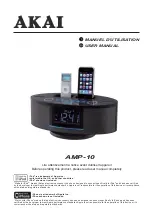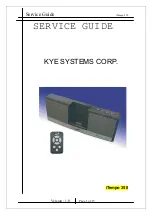
4
With the separate inputs for the midrange/tweeter and
woofer on the Treo’s, you may be tempted to bi-amplify the
speakers using a powerful amplifier or an amplifier known
for superb bass performance on the woofer input and a
smaller amplifier or an amplifier renowned for middle and
high frequency performance on the midrange/tweeter input.
But rather than improving the sound of your system with the
addition of a second amplifier, you will have taken a signifi-
cant step backwards in coherence, accuracy and musical re-
alism.
The reasons for this sonic penalty are simple. One of the
strongest aspects of the Model Treo’s performance is the
seamless transition between the drivers. Whether the music
is in a range being reproduced by the woofer, by the mid-
range, or equally by both drivers, there is no audible change
to the characteristics of the instruments or voices.
But, when the midrange driver is being driven by a different
amplifier than the woofer, (and in these cases by amplifiers
not chosen for the similarity in their sounds, but rather for
the difference in their sounds), the blending between the
drivers is compromised and the sonic consistency of the
speaker is inhibited.
Even if the levels of the two amplifiers are matched for
one volume level, the amplifiers will still exhibit different
dynamic characteristics, different imaging characteristics,
different degrees of detail and instrument texture and differ-
ent tonal balances. With the crossover between the woofer
and midrange occurring in a range where the ear is very sen-
sitive to any sonic changes, these differences will create con-
siderable sonic confusion through the important midrange.
The only way to properly bi-amplify the Model Treo is
passively, with two identical amplifiers in a vertical configu-
ration. (one stereo amplifier per channel) An electronic
crossover cannot be used since the crossover in the Model
Treo is not bypassed. The result would be two crossovers in
series creating severe phase shift. The use of two different
amplifiers or an electronic crossover will negatively affect
the sound of the speakers and reduce their overall perform-
ance level. Note: one stereo or two mono amplifier will usu-
ally out perform bi-amplification.
The effects of bi-wiring are not subtle. The improve-
ments are large enough that a bi-wire set of moderately
priced cable will usually sound better than a single run of far
more expensive cable.
All the cables in a bi-wire set must be the same. There is
often great temptation to use a wire known for good bass
response on the woofer inputs and a different wire known
for good treble response on the midrange/tweeter inputs.
This will cause the different sonic characteristics of the two
wires in the middle frequencies to interfere with the proper
blending of the woofer and midrange driver through the
600Hz crossover point. The consistency of the sound will be
severely affected as the different sounding woofer and mid-
range drivers conflict with each other in the frequency range
where our ears are most sensitive to sonic anomalies. The
disappointing result is a vague image, a lack of transparency
through the midrange and lower treble and loss of detail and
clarity.
Some of the benefits of bi-wiring seem to come from the
physical separation of the high current bass and low current
midrange/tweeter wires. Cables that combine the wires in
one sheath do not offer the full advantages of bi-wiring.
The cables should all be the same length. This is not due
to the time that the signal takes to travel through a cable, but
rather that two different lengths of the same cable will sound
different. If the cables connecting one speaker are a differ-
ent length than the cables connecting the other speaker, the
resulting difference in sound between the two speakers will
compromise the imaging and coherence of the system. If
different lengths of cable are used for the bass and midrange/
tweeter inputs of the speakers, the effects will be similar to
those experienced when using two different cables as de-
scribed above.
Since short runs of speaker cable sound better than long
runs, consider placing your electronics between the speakers
rather than off to one side. If for convenience or aesthetic
considerations, the electronics must be located a consider-
able distance from the speakers, it is usually preferable to
place the amplifier between the speakers and use long inter-
connect cables and short speaker wire.
B
I-
W
IRING
T
HEORY
A
ND
P
RACTICE
B
I-
A
MPLIFICATION
T
HEORY
A
ND
P
RACTICE
When you vertically bi-amplify with two identical amplifi-
ers, almost every aspect of the Model Treo’s performance
is enhanced compared to bi-wiring with just one of the am-
plifiers. In most cases however, bi-wiring with a single,
twice-as-expensive, better sounding amplifier will offer
greater performance improvements for the same invest-
ment.
W
E
R
ECOMEND
A. All speaker cables in bi-wired or bi-amped systems
should be the same type and length. While certain dif-
ferent cables may work well together, identical cables
on both inputs insures perfect blending.
B. If your amplifier has “A” and “B” outputs, use the “A”
outputs for both cables in bi-wired systems. The two
sets of outputs may not be electrically identical.
C. If your amplifier has multiple impedance taps, try the 4
ohm and 8 ohm taps to see which sounds better. (They
will sound different). The 2Ce Signature II is an easy
load so there is no danger of damaging your amplifier
or the speakers by using either set of taps. In bi-wired
and bi-amped systems, both cables must be connected
to the same rated taps on the amplifier.






























